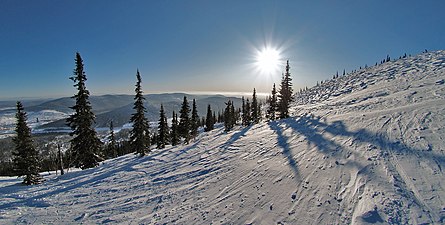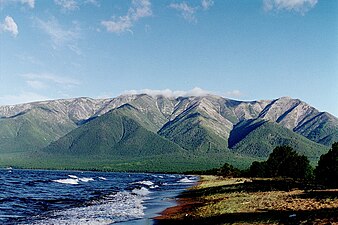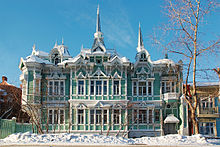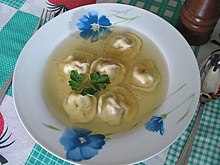
Siberia located in Russia, with an area of nearly 10 million square kilometers, it's huge. The common view of Siberia is wild nature and penal colonies, the reality is different. The adjoining federation districts are Ural and far East.
Regions

Oblasts:
- Irkutsk - a huge area between Lake Bajkal in the southeast and the Saiani Mountains in the southwest
- Kemerovo - Siberian conditions, the area is populous, urban and industrialized
- Novosibirsk - is located in the south of the West Siberian lowlands between the Irtysh and Ob rivers
- Omsk - in the south of the West Siberian lowlands
- Tomsk - is sparsely populated, spacious, flat, wooded and yes, it gets pretty cold in winter
Regions:
- Altai - vast steppes with salty lakes, ledges and mountains
- Krasnoyarsk - is the largest region of Central Siberia, it covers a huge area from the Sayan Mountains to the Arctic Ocean
- Transbaikalia - with great diversity and beauty of its landscapes
Republics:
- Altai - Located in the south of Siberia between Kazakhstan and Mongolia
- - Often referred to as the archaeological Mecca of Siberia because of its enormous amount of important archaeological sites
- Tuva - belonged to the Chinese Empire for centuries, extremely remote due to the lack of traffic routes and relatively few tourists
- Buryatia - in the middle of Asia, on the east bank of Lake Baikal, next to Mongolia
Transbaikalia and Buryatia have been part of the confederation circle since 2019 far East

places
- 1 Novosibirsk
 - the administrative capital of Siberia, the third largest city Of Russia and home to more than half of the residents of the Novosibirsk Oblast.
- the administrative capital of Siberia, the third largest city Of Russia and home to more than half of the residents of the Novosibirsk Oblast.
- 2 Krasnoyarsk
 - is not a popular travel destination, although there is a lot to see here. The city is interesting for its historical heritage: pre-revolutionary houses are no less interesting here than in Yeniseisk; among them there are carved wooden and trading houses and even large trading arcades of great proportions. Another, no less interesting variant of the Krasnoyarsk plurality is natural. The city is located on the slopes of the Eastern Sayan, which together with the Yenisei form a unique relief: bare hills and rocks covered with taiga. In Krasnoyarsk it is worthwhile to stay at least a few days, one of which should include the following places: the famous bridge piers or a drive along the Yeniseis towards the Krasnoyarsk hydroelectric power station.
- is not a popular travel destination, although there is a lot to see here. The city is interesting for its historical heritage: pre-revolutionary houses are no less interesting here than in Yeniseisk; among them there are carved wooden and trading houses and even large trading arcades of great proportions. Another, no less interesting variant of the Krasnoyarsk plurality is natural. The city is located on the slopes of the Eastern Sayan, which together with the Yenisei form a unique relief: bare hills and rocks covered with taiga. In Krasnoyarsk it is worthwhile to stay at least a few days, one of which should include the following places: the famous bridge piers or a drive along the Yeniseis towards the Krasnoyarsk hydroelectric power station.
- 3 Kemerovo
 - the capital and second largest city of Kuzbass. It would be strange to say that it is an industrial city as industry is ubiquitous in Kuzbass, but in the case of Kemerovo the industrial character is particularly tangible and visible. Littered with factory chimneys and shrouded in smoke, the city is cozier than it seems from the outside: it even has a place for pines and rocks, and it is worth coming here to visit the Red Hill - a small and very interesting museum reserve dedicated to the creation of the kuzbass industry. In the center of Kemerovo is a beautiful building from the Soviet era. The only road that connects Western Siberia with Eastern Siberia runs through the city, and beyond that there is its own airport.
- the capital and second largest city of Kuzbass. It would be strange to say that it is an industrial city as industry is ubiquitous in Kuzbass, but in the case of Kemerovo the industrial character is particularly tangible and visible. Littered with factory chimneys and shrouded in smoke, the city is cozier than it seems from the outside: it even has a place for pines and rocks, and it is worth coming here to visit the Red Hill - a small and very interesting museum reserve dedicated to the creation of the kuzbass industry. In the center of Kemerovo is a beautiful building from the Soviet era. The only road that connects Western Siberia with Eastern Siberia runs through the city, and beyond that there is its own airport.
- 4 Irkutsk
 - the attractive capital and largest city; one of the main stops of the Trans-Siberian Railway and the gateway to Lake Baikal
- the attractive capital and largest city; one of the main stops of the Trans-Siberian Railway and the gateway to Lake Baikal

Novosibirsk
.jpg/338px-Красноярск_(ночной).jpg)
Krasnoyarsk

Kemerovo

Irkutsk
- 5 Barnaul
 - the capital of the Altai region
- the capital of the Altai region
- 6 Biysk
 - the gateway to the Altai Mountains.
- the gateway to the Altai Mountains.
- 7 Omsk
 - One of the most important cities in Siberia and one of the largest cities in Russia, an excellent stop on the Trans-Siberian Railway
- One of the most important cities in Siberia and one of the largest cities in Russia, an excellent stop on the Trans-Siberian Railway
- 8 Tomsk
 - The capital is a 400 year old Siberian city of historical importance and famous for its traditional wooden houses and neoclassical university buildings called "gingerbread".
- The capital is a 400 year old Siberian city of historical importance and famous for its traditional wooden houses and neoclassical university buildings called "gingerbread".

Barnaul
Biysk
.jpg/338px-4Y1A8528_(28090096565).jpg)
Omsk
Tomsk
- 9 Gorno-Altaysk
 is the capital of the Altai Republic and the only city on its territory. Together with the neighboring village of Mayma, it is the gateway to the Altai Mountains and a transit point where you do not have to stay particularly long, but can only visit the National Museum and spend the night comfortably.
is the capital of the Altai Republic and the only city on its territory. Together with the neighboring village of Mayma, it is the gateway to the Altai Mountains and a transit point where you do not have to stay particularly long, but can only visit the National Museum and spend the night comfortably.
- 10 Chita
 - the largest city and capital of the Transbaikalia region
- the largest city and capital of the Transbaikalia region
- 11 Ulan-Ude
 - is the administrative center of Buryatia, the heart of Russian Asia.
- is the administrative center of Buryatia, the heart of Russian Asia.
- 12 Ak-Dovurak

- 13 Novokuznetsk
 - the largest and oldest city in the region is the opposite of Kemerovo, a city that is not inhabited by miners, but by metallurgists. Also, the rare case that the largest city in the region is not the administrative center. Novokusnetsk has monuments from different eras and is easily one of the ten most interesting cities of Western Siberia. In old Kuznetsk there is a fortress from the 18th century. Century and fragments of the district town, while the new Kuznetsk - celebrated in Mayakovsky's "Garden City" - contains one of the best ensembles of Soviet architecture in the country. The city is also the site of Dostoyevsky's wedding. In addition, there is an airport, a good train service, the proximity of Kuznetsky Alatau - and Novokuznetsk becomes the best starting point for trips to the south of the Kemerovo region.
- the largest and oldest city in the region is the opposite of Kemerovo, a city that is not inhabited by miners, but by metallurgists. Also, the rare case that the largest city in the region is not the administrative center. Novokusnetsk has monuments from different eras and is easily one of the ten most interesting cities of Western Siberia. In old Kuznetsk there is a fortress from the 18th century. Century and fragments of the district town, while the new Kuznetsk - celebrated in Mayakovsky's "Garden City" - contains one of the best ensembles of Soviet architecture in the country. The city is also the site of Dostoyevsky's wedding. In addition, there is an airport, a good train service, the proximity of Kuznetsky Alatau - and Novokuznetsk becomes the best starting point for trips to the south of the Kemerovo region.
Other goals
- 1 Baikal lake - lies between Buryatia and Irkutsk, is the deepest and oldest lake in the world and at the same time the largest freshwater body on the planet.
- 1 Scheregesch - the all-Russian ski area in Gornaya Shoriya.
- Listvyanka

Scheregesch

Lake Baikal, Swijatoj Nos Island (Holy Nose)
background
With an area of almost 10 million square kilometers, Siberia is huge. The common view of Siberia is wild nature and penal colonies, the reality is different. The west of Siberia is covered by a swampy plain, the central plateau is heavily forested, and in the east there are mountains that rise up to over 3,000 m. Only the extreme north is a real tundra, where temperatures can reach -68 ° C in winter. The Siberian population, like most Asian Russians, is more closely related to the people of Kazakhstan or Mongolia or to the Inuit than to the European Russians. However, during the Soviet era, the government spent money to lure Europeans to the larger cities of Siberia. Today, Europeans form the majority in the urban areas, while the rural areas are still largely inhabited by the Siberian indigenous population.
language
The languages spoken in Siberia are diverse, with many individual dialects. However, one understands and speaks Russian almost everywhere. English is rarely spoken, except by a few young people, and even then Russian is more popular.
getting there

By plane
 Irkutsk airport (IATA: ICT), Shiryamova st. d. 13, Irkutsk, Irkutsk Oblast, Russia. Tel.: 7 (0)395 226 62 77, 7 (0)395 226 60 60, Fax: 7 (0)395 226 64 00, 7 (0)395 226 64 55. is one of the main airports in Russia, receiving international flights from Mongolia, China, South Korea, Thailand and Uzbekistan. Domestic flights are available from most major Russian airports, including Saint Petersburg, Moscow, Khabarovsk, Yekaterinburg, Vladivostok and many others.
Irkutsk airport (IATA: ICT), Shiryamova st. d. 13, Irkutsk, Irkutsk Oblast, Russia. Tel.: 7 (0)395 226 62 77, 7 (0)395 226 60 60, Fax: 7 (0)395 226 64 00, 7 (0)395 226 64 55. is one of the main airports in Russia, receiving international flights from Mongolia, China, South Korea, Thailand and Uzbekistan. Domestic flights are available from most major Russian airports, including Saint Petersburg, Moscow, Khabarovsk, Yekaterinburg, Vladivostok and many others.
 Kemerovo International Airport (Международный Аэропорт Кемерово, IATA: KEJ) (10 km south of Kemerovo).
Kemerovo International Airport (Международный Аэропорт Кемерово, IATA: KEJ) (10 km south of Kemerovo).
 Novosibirsk-Tolmachevo Airport (Толмачёво, Международный аэропорт Новосибирск (Толмачёво), IATA: OVB), Ob, Novosibirsk Oblast, Russia, 633104, Обь, Новосибирская обл., 633104. Tel.: 7 383 216-99-99. The airport is 16 km from the city center and has over 4 million passengers a year. There are regular flights to many major Russian cities, including Moscow, Saint Petersburg, Khabarovsk, Vladivostok, Krasnodar, Omsk, Ulan-Ude, Samara and Ufa, and Yekaterinburg, as well as international flights to Dushanbe, Istanbul, Baku, Prague, Yerevan, Beijing, Almaty, Osh, Bishkek and Dubai.
Novosibirsk-Tolmachevo Airport (Толмачёво, Международный аэропорт Новосибирск (Толмачёво), IATA: OVB), Ob, Novosibirsk Oblast, Russia, 633104, Обь, Новосибирская обл., 633104. Tel.: 7 383 216-99-99. The airport is 16 km from the city center and has over 4 million passengers a year. There are regular flights to many major Russian cities, including Moscow, Saint Petersburg, Khabarovsk, Vladivostok, Krasnodar, Omsk, Ulan-Ude, Samara and Ufa, and Yekaterinburg, as well as international flights to Dushanbe, Istanbul, Baku, Prague, Yerevan, Beijing, Almaty, Osh, Bishkek and Dubai.
 Barnaul Airport (Барнаул, IATA: BAX). The international airport has flights to Anapa, Vladivostok, Irkutsk, Krasnoyarsk, Moscow, Norilsk, Saint Petersburg, Sochi, Khabarovsk and Yakutsk. There are also international transport connections with charter flights to Antalya, Bangkok, Dushanbe and Sharm el-Sheikh.
Barnaul Airport (Барнаул, IATA: BAX). The international airport has flights to Anapa, Vladivostok, Irkutsk, Krasnoyarsk, Moscow, Norilsk, Saint Petersburg, Sochi, Khabarovsk and Yakutsk. There are also international transport connections with charter flights to Antalya, Bangkok, Dushanbe and Sharm el-Sheikh.
 Kadala Airport (IATA: HTA). is about 13.5 km west of Tschita. It has a stop on the Trans-Siberian Railway. There are airlines from Moscow-Ural Airlines and S7 (Siberia) with regular flights. Direct flights to / from Yekaterinburg are available. For Moscow, it is recommended that everyone in Chita take the train to Irkutsk and fly from there, as it is much cheaper. There is also an occasional connection to Beijing twice a week via Hailer with Air China, but this is regularly canceled, so you have to take the train.
Kadala Airport (IATA: HTA). is about 13.5 km west of Tschita. It has a stop on the Trans-Siberian Railway. There are airlines from Moscow-Ural Airlines and S7 (Siberia) with regular flights. Direct flights to / from Yekaterinburg are available. For Moscow, it is recommended that everyone in Chita take the train to Irkutsk and fly from there, as it is much cheaper. There is also an occasional connection to Beijing twice a week via Hailer with Air China, but this is regularly canceled, so you have to take the train.
 Jemelyanovo Airport (Аэропорт Емельяново, IATA: KJA). (engl. Yemelyanovo) is a hub for flights within Siberia and to some important cities in neighboring countries. All three major Moscow airports are served. The Russian airline Nordstar has a hub here and also flies to many Russian cities Beijing in regular services.
Jemelyanovo Airport (Аэропорт Емельяново, IATA: KJA). (engl. Yemelyanovo) is a hub for flights within Siberia and to some important cities in neighboring countries. All three major Moscow airports are served. The Russian airline Nordstar has a hub here and also flies to many Russian cities Beijing in regular services.
 Baikal Airport (Аэропорт «Байка́л», IATA: UUD). offers flights within Siberia and Russia as well as some important cities in neighboring countries.
Baikal Airport (Аэропорт «Байка́л», IATA: UUD). offers flights within Siberia and Russia as well as some important cities in neighboring countries.
 Abakan Airport (Аэропорт Абакан, IATA: ABA). The Moscow - Abakan route is served daily by two airlines: Siberia (S7) and Aeroflot. Departure from Moscow at night, arrival in Abakan between 6:00 and 7:00 a.m.
Abakan Airport (Аэропорт Абакан, IATA: ABA). The Moscow - Abakan route is served daily by two airlines: Siberia (S7) and Aeroflot. Departure from Moscow at night, arrival in Abakan between 6:00 and 7:00 a.m.
By train

The Trans-Siberian Railway, the Moscow With Vladivostok connects is by far the most famous transport route in Siberia. With a length of 9,289 kilometers, it is one of the longest railways in the world. Driving the entire route takes 6 days and crosses 8 time zones.
It is less well known Baikal-Amur Mainline (BAM), a northern line that runs parallel to the Transsib for 4,234 km. It leads from Tayshet via Tynda to Sovetskaya Gawan. It is an alternative route (shown in green on the map) to the Trans-Siberian (shown in red), as, unlike the latter, it passes north of Lake Baikal. It is further away from the border with China and is less popular with tourists.
In the street
The Trans-Siberian Highway is an unofficial grouping of seven Russian federal highways. It opens the way for an 11,000 km off-road journey from St. Petersburg and Moscow to Vladivostok. The last section, the Amur Highway, was not paved until 2010.
mobility
Tourist Attractions
In Tomsk there are more monuments of Wooden architecture in the style of Siberian baroque, art nouveau and classicism has been preserved than anywhere else in Russia. Much of this splendor has been lost for various reasons, but something has been preserved. In many quarters you can still see traditional Siberian wooden buildings, houses decorated with filigree carvings.

Tomsk, 19 Belinsky Street

The house with firebirds - Дом с жар-птицами
activities
Siberia, with its vast wilderness areas, is an outstanding travel destination for people who love life in nature.
- Fishing trips on lakes and rivers
- hikes
- to pick mushrooms
- Nature observation
- Wildwater Rafting
In the winter
- Snowboarding
- To ski
- Cross-country skiing
- Dog sledding
- Ice fishing on lakes and rivers
kitchen
Fishing and hunting are among the oldest pastimes in Siberia and are still popular today. Game and fish, taiga herbs, berries and mushrooms are therefore part of the regional dishes.
- At Siberian Pelmeni it is noodles filled with meat, which are now a Russian national dish. The small dumplings are usually filled with a mixture of pork, beef or game meat. Boiled in water or hearty broth, they are enjoyed as a main course with various sauces or as an insert in a hearty bouillon. They are also popular with hot melted butter and sour cream, or with spicy tomato sauce.

Pelmeni as a soup

Pelmeni with sour cream
- Cedar nuts (кедровые орехи) are very similar to pine nuts from the Mediterranean region. However, they grow in the taiga. The nutritious kernels can simply be nibbled or processed into oil, puree and other products. The kernels are extracted from the cones of the Siberian stone pine; it grows in the rough and cold regions of the taiga and in the Altai mountains. In Siberia they are offered on the street, with us you can usually get them in health food stores or health food stores.
_(Pinus_koraiensis).jpg/220px-Jat_(pine_nut)_(Pinus_koraiensis).jpg)
peeled kernels

you can buy cedar nuts here
- At Yukola (юкола) is dried fish.
Yukola
nightlife
The nightlife takes place mainly in the big cities, otherwise just enjoy nature.
security
You should prepare for extreme climates, especially in winter you need suitable clothing to protect yourself against the cold. It is helpful, whenever possible, to use local sources of information to be warned of floods, forest fires, etc. There are forbidden areas that you should avoid as much as possible.
The nature is very pristine and represents a danger for the inexperienced. If you stay in the forest, you should watch out for snakes, which usually warm up in the sun on the stones. There aren't many of them around, but some could be venomous vipers. The other problem these (and other regions of the Northern Hemisphere) have is ticks. Your bites may be infectious, vaccinations are recommended.
One should never stray further from human settlements without the appropriate equipment and leave the path, destination and intended period of the hike or rafting tour behind with every tour.
climate
Most regions have a continental climate, hot summers up to 40 ° C and extremely cold winters with temperatures below - 60 ° C. In the north there is permafrost, i.e. the ground is permanently frozen and in the warm season it only thaws superficially. Rain and condensation cannot seep into the deep frozen ground and remain on the surface. In the short summer the ground becomes muddy and there is a lot of water and therefore an extreme abundance of mosquitoes.
Climate change is also evident in Siberia through more frequent massive floods and increased forest fires.
trips
In the west lies the Ural, in the east the region Far East, in the south the neighboring countries Kazakhstan, the region Xinjiang in China and the Mongolia.






.jpg/338px-Красноярск_(ночной).jpg)








.jpg/338px-4Y1A8528_(28090096565).jpg)


.JPG/350px-Казанский_кафедральный_собор_(3).JPG)











.JPG/344px-Аэропорт_Чита_(1).JPG)







_(Pinus_koraiensis).jpg/220px-Jat_(pine_nut)_(Pinus_koraiensis).jpg)

